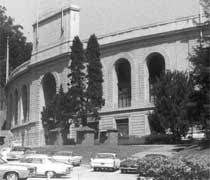We posted yesterday about the news from UC-Berkeley that many earthquake-prone buildings are located in southern California – including in Westwood. The Westwood-Century City Patch, in picking up the story from the LA Times, blamed USC instead of UC-B, at least in the headline. See above. Probably just as well. Who wants to be the bearer of bad tidings?.
Category: UC Berkeley
UC-Berkeley Releases Its Earthquake Survey to the LA Times
We have followed the LA Times‘ story of the concern about certain concrete buildings in the southern California area which might be at risk in a major earthquake. The Times identified some buildings in an earlier story but noted that UC-Berkeley had a survey list of buildings. Berkeley was reluctant to provide the list because its intent was to get an estimate of the number of such buildings based on public records rather than evaluate each building directly. It has now provided the Times with the list, along with a legal disclaimer. The Times now has an interactive map on its website along with an article. I punched in “Westwood” in the search engine on the map and got the result seen above. (I have deleted one building which was not in Westwood but had the name Westwood in its title. There are also other buildings in the Westwood area that can be found by searching but which do not appear under a “Westwood” search.) Click on the image above to enlarge and clarify. Or go the the Times article and search for whatever you like.
The Times article, from which you can obtain the map, is at:
http://www.latimes.com/local/lanow/la-me-ln-concrete-buildings-list-20140125,0,4256501.story
The disclaimer from Berkeley is at:
http://documents.latimes.com/uc-concrete-list-disclaimer/
Quake Response
We noted in a prior post there would be increased attention to earthquake risks in LA around the 20th anniversary of the Jan. 27, 1994 Northridge quake. One item that began to develop was an LA Times article indicating that various buildings were at risk in the LA area, even though they were thought safe when constructed. One of the buildings in Westwood is owned by UCLA, which asserted that it had been upgraded. It was also reported that a team of researchers at Berkeley had compiled a list of such buildings, but was not making the list available due to litigation concerns. The LA Times now indicates that the list will be made available. See http://www.latimes.com/local/lanow/la-me-ln-list-of-buildings-at-risk-in-earthquake-will-be-released-to-la-20140117,0,3874307.story
Is the ball still in their court or has the train left the station?
 |
| Hey! Let’s rebuild the old stadium! |
Sorry to mix metaphors. But Inside Higher Ed today has a long story on Berkeley athletics which have recently been in the news for low graduation rates and problems in funding a stadium upgrade. A white paper from the Berkeley Center for the Study of Higher Education suggests that the program is running as an autonomous and relatively uncontrolled business operation. It is written by a former vice chancellor – who can now tell all -and a Berkeley grad student.
See http://cshe.berkeley.edu/sites/default/files/shared/publications/docs/ROPS.CSHE_.12.13.Cummins%26Hextrum.CalAthletics.1.6.2014.pdf and http://www.insidehighered.com/news/2014/01/08/highlighting-berkeley-paper-explores-academic-damage-expanding-independent-athletics
The issue is whether control can be retaken or whether – another metaphor!! – the ship has sailed. Would the Regents like to discuss this matter at their upcoming January 21-23 meeting? The stadium at least does involve a grand capital project they approved (and which seems not to have worked out as planned; who would have thought?). Anyway, it’s just a suggestion the Regents might want to consider. But maybe they figure that the ball is no longer in their court and the train has left the station.
Or maybe the ship has sailed:
[youtube http://www.youtube.com/watch?v=OqVrLdN7d68?feature=player_detailpage]
Yesterday’s news
Christmas day tends to be a slow news day. However, for those who didn’t see it, the LA Times carried a front page story about UC’s online offerings which allow cross-campus credits. You can find the article at:
http://www.latimes.com/nation/la-me-uc-online-20131222,0,6798231.story
Blog readers will be familiar with these offerings. We noted in a prior post that UCLA seems to be a taker rather than a giver in this endeavor. That is, other campuses’ online courses are available to UCLA students. But UCLA is not offering courses to the other campuses. Berkeley, Irvine, Davis, and Riverside seem to be the offerers.
Now, how about next year’s UC budget, governor? The headline above should make you happy:
[youtube http://www.youtube.com/watch?v=2U-rBZREQMw?feature=player_detailpage]
UC Berkeley prof says its future is as a ‘finishing school for the superrich of Asia’
The headline for this posting is a direct quote from a headline to an article in the San Francisco Business Times which you can find at www.bizjournals.com/sanfrancisco/news/2013/12/16/uc-berkeley-finishing-school-asia-rich.html
The (economics) professor in question is Brad DeLong. For your information, below is the portion of his post on the Berkeley Blog that deals with the subject of that headline:
…(Partially) a Finishing School for the Superrich of Asia
The first priority of the chancellor is to successfully execute a strategy to keep Berkeley great–to reinforce the reasons that it is worthwhile keeping a university like Berkeley around at all.
The days of Clark Kerr are over. The belief that the taxpayers of California should pay for the young citizens of California to get as much education as they want for free is no longer politically popular. Would that it were still. The old social democratic belief that America should have the best universal free public education system in the world was a principal source of America’s relative prosperity and economic leadership for a century. Now that the political coalition that supported that belief is gone, America will be a much less exceptional place.
But those days are gone. Chancellors can no longer rely on the legislature of California to fund Berkeley at the level needed to keep it an exceptional university. Berkeley needs another and a different strategy.
The strategy that Berkeley has settled on is to seek to produce the funding stream necessary to maintain a great University by becoming a finishing school for the superrich of Asia. This may be the wrong strategy–I sometimes think so, many others think so, and you can certainly argue so. But it is the strategy that we have. And the worst strategy of all is to have no strategy.
A bad strategy is vastly preferable to no strategy, or to an unimplemented strategy. So the chancellor needs to implement the strategy that we have, and that requires throwing money at three areas:
- Student Life: You can take the kids who have grown up in Orange County and throw them unsupervised and unsupported into Berkeley and they will do fine. You cannot do that with kids from Bangalore or Kuala Lumpur or Chungking. Dormitories, advisors, student life support–all dimensions of administrative activities that Berkeley has historically skimped on need to be beefed-up, and beefed up substantially. Every dollar of available money should, for the next five years at least, be devoted to this task.
- Presentation-of-Self in English: The English-speaking and oral comprehension skills of the future students who will rebalance Berkeley’s finances are first-rate or they would not be seeking admission. Their English-language prose-writing skills are not. If Berkeley is to provide value, the money must flow like water to writing teachers and writing coaches. And also drama teachers. The principal thing Berkeley can teach the smart and well-prepared children of the superrich of Asia that they will find useful and worthwhile is presentation-of-self in global English-speaking culture. To do that requires: (a) convincing the out-of-state students that they need to learn how to write and also how to act, (b) beefing up the English department to teach them how to write, and (c) beefing up the drama department to teach them how to act. We have already devoted every dollar of available money to our first task, but the second task needs to be funded and funded amply as well. So the rest of the university needs to be squeezed to produce the money to do this.
- Key Subject Areas: High-fee-paying out-of-state students will come and pay high fees only if they can reliably get the courses and majors that they want, and have them taught well. This means that money has to flow like water to engineering (especially computer science) and biological sciences (especially pre-medical) and economic sciences (especially finance) and international studies (especially economics). These particular customers are kings. And the money that flows has to flow to effective teaching–and not to raising the living standards and laboratory setups of senior faculty. God knows how the chancellor will persuade departments that they have the budget so that everyone who wants to major in computer science, biological sciences, economics, business, etc. can and will do so — as we have already spent every dime and more on student life, English, and Drama — but the chancellor will have to do so. Throwing money like water at key areas that require expansion and emphasis in a time of general budgetary retrenchment is the hardest thing an academic administrator can ever do. Yet the chancellor has to do it, lest Berkeley become just another urban state university campus, rather than something exceptional and valuable…
The full post – which deals also with tuition and online ed – is at http://blogs.berkeley.edu/2013/12/11/well-its-the-end-of-nicholas-dirkss-first-semester-as-berkeley-chancellor-so-why-not-offer-him-some-unsolicited-advice/
PS: Whatever your opinions on the excerpt reprinted above, it is interesting that UC-Berkeley has an official blogsite on which faculty can express controversial views about the university itself. Would UCLA sponsor such a blogsite? Would other UC campuses?
A Berkeley Admissions Dossier Reader Tells All
Yours truly confesses he missed an August 1 article in the NY Times concerning the UC-Berkeley admissions process (which undoubtedly applies to UCLA as well). The article gets into the sensitive area of admissions in the post-Prop 209 era. [Prop 209 bans affirmative action in admissions.] Since you may also have missed it, here is an excerpt below with a link to the full article:
A HIGHLY qualified student, with a 3.95 unweighted grade point average and 2300 on the SAT, was not among the top-ranked engineering applicants to the University of California, Berkeley. He had perfect 800s on his subject tests in math and chemistry, a score of 5 on five Advanced Placement exams, musical talent and, in one of two personal statements, had written a loving tribute to his parents, who had emigrated from India… The reason our budding engineer was a 2 on a 1-to-5 scale (1 being highest) has to do with Berkeley’s holistic, or comprehensive, review, an admissions policy adopted by most selective colleges and universities. In holistic review, institutions look beyond grades and scores to determine academic potential, drive and leadership abilities. Apparently, our Indian-American student needed more extracurricular activities and engineering awards to be ranked a 1… when I asked about an Asian student who I thought was a 2 but had only received a 3, the officer noted: “Oh, you’ll get a lot of them.” She said the same when I asked why a low-income student with top grades and scores, and who had served in the Israeli army, was a 3. Which them? I had wondered. Did she mean I’d see a lot of 4.0 G.P.A.’s, or a lot of applicants whose bigger picture would fail to advance them, or a lot of Jewish and Asian applicants (Berkeley is 43 percent Asian, 11 percent Latino and 3 percent black)? …
Full article at mobile.nytimes.com/2013/08/04/education/edlife/lifting-the-veil-on-the-holistic-process-at-the-university-of-california-berkeley.html
Lessons from Berkeley’s White Elephant Stadium for UCLA, the Regents, and UC?
People keep noticing Berkeley’s White Elephant money-draining stadium – one of the grand capital projects that the Regents routinely approve based on pretty slides and business plans offered by the campuses. Peter Schrag in the San Francisco Chronicle today ties the low graduation rates of Berkeley athletes with the stadium:
…Fueling the… issue is the chronic matter of cost – what the university kicks in to the sports program – and what someone called “its gold plated” spending. Brian Barsky, a Berkeley computer science professor and vocal critic of the athletics program, says between 2003 and 2011, athletics “drained campus coffers of more than $88 million that could have been used instead to support the university’s core mission.” Cummins and Hextrum talk about “accumulating deficits over nearly 20 years totaling some $170 million at a time when the campus faced substantial staff layoffs and furloughs.” [Sandy Barbour, Berkeley’s director of athletics,] claims those numbers are flat wrong. With the exception of one year, she said, there have been no deficits. But there’s no question that its football and basketball coaches, like other big time coaches, earn 10 times as much as the average full professor, or that Barbour gets paid more than the chancellor, or that the sports program isn’t self-supporting. More important still is the huge debt UC Berkeley faces for the cost of the recent rebuilding of Memorial Stadium and the construction of the adjacent “Student-Athlete High Performance Center” – all together totaling more than $450 million, some of it to be paid by 100-year “century” bonds. All told, including interest, those facilities will eventually cost $1.25 billion. Paying it off depends on football. And given the dismal records of the past two seasons and the disappointing sales of expensive long-term rights to seats in the stadium – originally priced at $225,000 apiece – that were supposed to help retire the bonds, a strategy since supplemented by a “more diversified approach,” that’s hardly a sure thing. What is a sure thing is that Berkeley has mortgaged itself in perpetuity to the success of its football team.
Full column at www.sacbee.com/2013/12/01/5953595/peter-schrag-has-uc-berkeley-mortgaged.html
There are lessons to be learned here by UCLA [the Grand Hotel], the Regents, and all the campuses. But will there be lessons taken? So far, however, there is little sign of such learning. If Gov. Brown is as concerned as he says he is about dealing with UC budget affairs, he might consider attending meetings of the Regents’ Committee on Grounds and Buildings and maybe putting some state auditors to work on analyzing what has been approved over the past few years.
Berkeley admits to serious student-athlete flaws
From the San Francisco Chronicle: UC Berkeley officials, responding to recent reports of lax admissions standards and poor graduation rates among student athletes, admitted this week that the university has a serious problem that is at times exacerbated by the desire to succeed on the field. “At a point, the pressure to win caused us to put more focus on the athletic piece and, as a result, we saw less performance on the academic side,” said Cal Athletic Director Sandy Barbour…
“We have an issue. No doubt,” said Barbour…. “It’s a serious one. And we have taken several measures to correct it. We’re not done.” The acknowledgment comes in the wake of NCAA data that showed Cal’s football and men’s basketball teams have the lowest graduation rates among 72 major-conference schools, 44 and 38 percent respectively…
Full story at http://www.sfgate.com/collegesports/article/Cal-admits-to-serious-student-athlete-flaws-4995278.php
For Your Information: Request from Berkeley Faculty Assn.
The request to circulate the item below was received by Prof. Meranze of the UCLA Faculty Assn. board from the UC-Berkeley Faculty Assn.:







